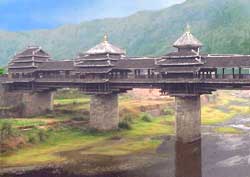
Interesting enough, the Sanjiang Bridges reflect the ethnic diversity and architectural ingenuity of the Chinese people. The Guangxi province in particular is a melting pot of ethnic minorities (Dong, Miao, Yao, and Zhuang). The Dong tribe is responsible for the construction of these bridges having given them beautiful names: “Wind and Rain” bridges. There are several “Wind and Rain” bridges in Guangxi but the Sanjiang Bridges stand out.
These bridges are covered pathways that are artistically designed pavilions and balconies. The erected bridges act as shelter for the people in harsh weather conditions. The name of the structures is “Wind and Rain” simply because it protects the Dong people from wind and rain.
The bridges are constructed using wood and stone. A visit to the insides of the bridge will make you think that the bridge is a house in itself. The bridges have kiosks designed by people who have a background in architectural design. The parts of the building are brilliantly placed to support the structure. When you look at the whole building through its entrance, you wouldn’t think that you are entering a bridge at all.
The amazing part about these structures is that the Dong people did not use nails to bind the wood together. They used the art of dove-tailing. The process surprisingly supports the bridges that are still standing up to this day.
You can take a trip to one of the bridges and sit at one of the benches. You look outside and see the lush greens of the tea trees, the people minding their business. A simple life where the only hint of technology are the waterwheels.
The Sanjiang Bridges exhibit the brilliance of the people.

Sanjiang Bridges

No comments:
Post a Comment
Feel free to place you thoughts here